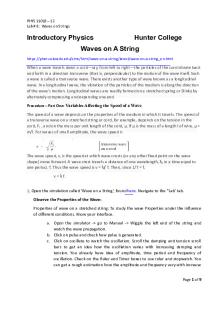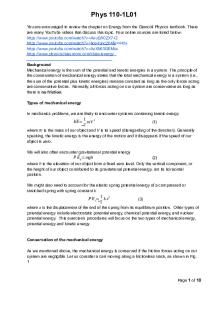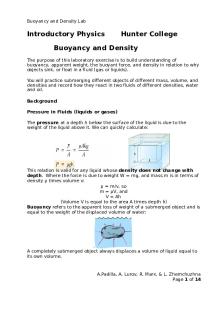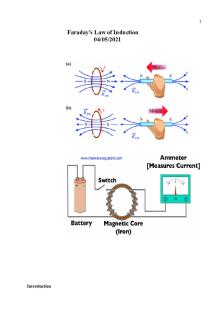Phys lab 8 - Lab report PDF

| Title | Phys lab 8 - Lab report |
|---|---|
| Author | Jeffrey Jakubz |
| Course | General Physics: Introductory Course In Mechanics Heat And Sound |
| Institution | Hunter College CUNY |
| Pages | 9 |
| File Size | 718.2 KB |
| File Type | |
| Total Downloads | 30 |
| Total Views | 181 |
Summary
Lab report...
Description
PHYS 110LB – 12 Lab # 8: Waves on Strings
Introductory Physics
Hunter College
Waves on A String https://phet.colorado.edu/sims/html/wave-on-a-string/latest/wave-on-a-string_en.html
When a wave travels down a cord—say, from left to right—the particles of the cord vibrate back and forth in a direction transverse (that is, perpendicular) to the motion of the wave itself. Such a wave is called a transverse wave. There exists another type of wave known as a longitudinal wave. In a longitudinal wave, the vibration of the particles of the medium is along the direction of the wave’s motion. Longitudinal waves are readily formed on a stretched spring or Slinky by alternately compressing and expanding one end. Procedure – Part One: Variables Affecting the Speed of a Wave
The speed of a wave depends on the properties of the medium in which it travels. The speed of a transverse wave on a stretched string or cord, for example, depends on the tension in the cord, FT , and on the mass per unit length of the cord, μ. If μ is the mass of a length l of wire, μ = m/l. For waves of small amplitude, the wave speed is
The wave speed, v, is the speed at which wave crests (or any other fixed point on the wave shape) move forward. A wave crest travels a distance of one wavelength, λ, in a time equal to one period, T. Thus the wave speed is v = λ/ T. Then, since 1/T = f, v = λ f. 1, Open the simulation called ‘Wave on a String’, found here. Navigate to the “Lab’ tab. Observe the Properties of the Wave: Properties of wave on a stretched string: To study the wave Properties under the influence of different conditions. Know your interface. a. Open the simulator -> go to Manual -> Wiggle the left end of the string and watch the wave propagation. b. Click on pulse and check how pulse is generated. c. Click on oscillate to watch the oscillation. Scroll the damping and tension scroll bars to get an idea how the oscillation varies with increasing damping and tension. You already have idea of amplitude, time period and frequency of oscillation. Check on the Ruler and Timer boxes to use ruler and stopwatch. You can get a rough estimation how the amplitude and frequency vary with increase Page 1 of 9
PHYS 110LB – 12 Lab # 8: Waves on Strings
in damping and tension. Remember, the tension slider does not behave linearly — it operates on powers of two (High is 4x larger than Low). d. Change the conditions by clicking on the boxes at your right and try Fixed End, Loose End and No End to get an idea how the wave behaves under these conditions.
e. Describe motions of green beads. The green beads move in a manner in which they are equidistant to one another, and move vertically. f. Is this a transverse or longitudinal wave? This is a transverse wave, as the particles are moving perpendicularly to the motion of the wave. g. In which direction is the wave traveling compared to the disturbance, perpendicular or parallel? The wave is traveling perpendicularly compared to the disturbance caused by the oscilating machine. h. Do waves transfer matter? Waves do not transfer any matter, particles are only displaced temporarily until the disturbance is over.
2. Change one variable each time for the speed of wave by measuring distance and time. Use No End and Slow Motion. Trial
Amplitude(A)
Frequency (F)
Wavelength (λ)
Tension (T)
Damping(D)
Speed Distance/Time
default
1 cm
1.5 Hz
2.5 cm
Medium
None
7.5cm/2s=3.750 cm/s
Change A
0.5 cm
1.5 Hz
2.5 cm
Medium
None
5.0cm/1.35s = 3.704 cm/s
Change F
1 cm
1.0 Hz
3.75 cm
Medium
None
5.0cm/1.34s = 3.730 cm/s
Page 2 of 9
PHYS 110LB – 12 Lab # 8: Waves on Strings
Maximize T
1 cm
1.5 Hz
4.1 cm
High
None
5.0cm/0.82s = 6.098 cm/s
Minimize T
1 cm
1.5 Hz
0.9 cm
Low
None
5.0cm/4.02s = 1.244 cm/s
a. Insert screenshots for each trial Trial 1: A = 0.5cm
Trial 2: F = 1.0 Hz
Page 3 of 9
PHYS 110LB – 12 Lab # 8: Waves on Strings Trial 3: T = High
Trial 4: T = Low
b. What conclusions that you can make based on this experiment? The amplitude does not impact the velocity of the wave. If the frequency changes, the wavelength will naturally change. If they both change, the speed will remain constant. If the tension increases, the velocity increases. If tension decreases, the velocity decreases. c. Is v = λ x f the same as the measured speed? Default- 1.5 Hz * 2.5 cm = 3.75 m/s; measured speed = 3.75 m/s Trial 1- 1.5 Hz * 2.5 cm = 3.75 m/s; measured speed = 3.704 m/s Trial 2- 1.0 Hz * 3.75 cm = 3.75 m/s; measured speed = 3.73 m/s Trial 3- 1.5 Hz * 2.5 cm = 3.75 m/s; measured speed = 6.098 m/s Trial 4- 1.5 Hz * 2.5 cm = 3.75 m/s; measured speed = 1.244 m/s If the tension remains at a medium level, the velocity should be the same as the value of wavelength x frequency. There may be slight error in the measured speed due to human error. Page 4 of 9
PHYS 110LB – 12 Lab # 8: Waves on Strings Change in tension of the string will cause the velocity to differ from the value of wavelength x frequency. Procedure – Part Two: Reflection (Insert screenshots for each experiment) 3. Set No Damping and Medium Tension. Select Fixed End and send a Pulse. Observe the reflection and describe the wave motion.
The wave moves in the one direction, and after it reaches the fixed end, the amplitude becomes the inverse value. 4. Change to Oscillation. Describe the wave motion. Once the wave reaches the end of each fixed point, the new waves formed by the disturbance of the oscillation machine combine with the wave traveling backwards. This results in the
Page 5 of 9
PHYS 110LB – 12 Lab # 8: Waves on Strings amplitude of the wave increasing by the amplitude of the initial disturbance.
5. Select Loose End and send a Pulse. Observe the reflection and describe the wave motion. Once this end of the wave, the loose end moves and causes the wave to move in the same amplitude that it came from. Once it reaches the pulse machine, the amplitude becomes inverse because this machine has a fixed end.
6. Change to Oscillation. Describe the wave motion. Once the wave reaches the loose end, the wave travels in the same direction to the top of the end. Then the wave travels down the loose end and causes the wave to combine with the incoming wave, and increase in amplitude. After a few oscillations, the wave is disrupted by the incoming oscillations and then the overall amplitude decreases temporarily.
Page 6 of 9
PHYS 110LB – 12 Lab # 8: Waves on Strings
7. Compare the waves of oscillation between the Loose End and the Fixed End. The fixed end causes the wave to move in the opposite direction at once. The loose end however disrupts the movement of the wave and causes the motion pattern to change. For oscillation, the loose end causes the overall amplitude increase to be limited. Procedure – Part Three: Standing Wave
8. Set the Tension in the middle, no Damping, and Fixed End. Based on previous calculation, calculate, and find out the fundamental frequency (n=1) of standing wave. Describe and explain the simulation. Insert the screenshot here.
n=1, Fn=0.25Hz, Wavelength = 15cm = 2L, 1L = 7.5cm Page 7 of 9
PHYS 110LB – 12 Lab # 8: Waves on Strings v/wavelength=frequency; v/15cm = 0.25Hz, v=3.75 cm/s 9. Find out n=2 and 3 standing waves. Insert the screenshots here. n=2:
Frequency= 0.5Hz, wavelength = 7.5cm = 2L/2, L = 7.5cm v/7.5cm = 0.5Hz; v=3.75cm
Page 8 of 9
PHYS 110LB – 12 Lab # 8: Waves on Strings n=3:
Frequency=0.75Hz, wavelength = 5cm 5cm = 2L/3; L=7.5cm v/5cm = 0.75Hz; v= 3.75 cm/s
Page 9 of 9...
Similar Free PDFs

Phys lab 8 - Lab report
- 9 Pages

Phys lab 4 - Lab report
- 10 Pages

Phys lab 5 - Lab report
- 10 Pages

Phys lab 10 - Lab report
- 14 Pages

Phys lab report 2
- 14 Pages

PHYS Lab Report 3
- 7 Pages

Lab 8 - lab report
- 6 Pages

Lab 8 - lab report
- 3 Pages

LAB #8 - Lab report
- 4 Pages

Phys lab 6 - Lab report 6
- 13 Pages

Phys 208 Lab Report # 3
- 3 Pages

LAB Report #4 phys 224
- 5 Pages

PHYS 215 Vectors - Lab Report
- 2 Pages

Lab report 4 int phys
- 4 Pages

Lab 8 CHM - lab report
- 3 Pages
Popular Institutions
- Tinajero National High School - Annex
- Politeknik Caltex Riau
- Yokohama City University
- SGT University
- University of Al-Qadisiyah
- Divine Word College of Vigan
- Techniek College Rotterdam
- Universidade de Santiago
- Universiti Teknologi MARA Cawangan Johor Kampus Pasir Gudang
- Poltekkes Kemenkes Yogyakarta
- Baguio City National High School
- Colegio san marcos
- preparatoria uno
- Centro de Bachillerato Tecnológico Industrial y de Servicios No. 107
- Dalian Maritime University
- Quang Trung Secondary School
- Colegio Tecnológico en Informática
- Corporación Regional de Educación Superior
- Grupo CEDVA
- Dar Al Uloom University
- Centro de Estudios Preuniversitarios de la Universidad Nacional de Ingeniería
- 上智大学
- Aakash International School, Nuna Majara
- San Felipe Neri Catholic School
- Kang Chiao International School - New Taipei City
- Misamis Occidental National High School
- Institución Educativa Escuela Normal Juan Ladrilleros
- Kolehiyo ng Pantukan
- Batanes State College
- Instituto Continental
- Sekolah Menengah Kejuruan Kesehatan Kaltara (Tarakan)
- Colegio de La Inmaculada Concepcion - Cebu
